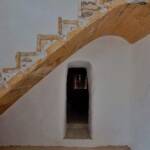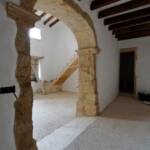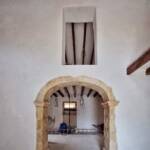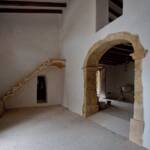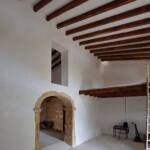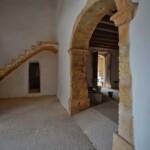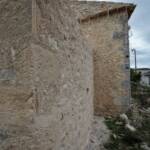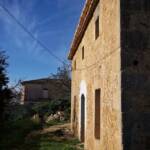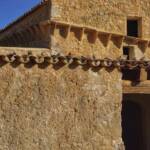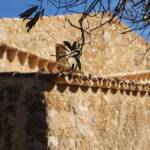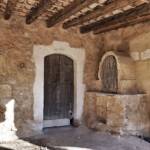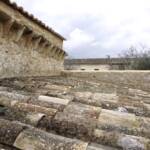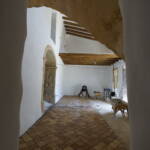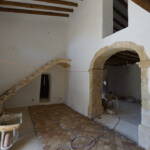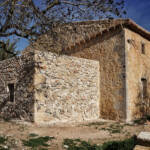 “Warning: although it remains like this for now, this house is not finished.”
“Warning: although it remains like this for now, this house is not finished.”
Looking at the photos of our latest work for Can Monroig, I wonder if the essence of the houses is not here, in this “unfinished” moment, before our own tastes, fashions, and the latest trends come through the door.

Entrance

Entrance
It is clear that we would like to start a restoration project by removing the rubble and end up putting some beautiful hand-woven linen curtains on the windows - so to speak - but it is not always like that and we need to be patient. As they say in Mallorca: “Poc a poc”. Old houses require time, time to restore them in the same philosophy with which they were built at the time; time to feel them and decide what life we want to lead in them.
And now that there is so much talk about slow philosophy or slow attitude, I would like to introduce a new term -or not so new- such as slow building movement or slow construction.

Opening portals
Chinese architect Wang Shu, who was awarded the Pritzker Prize in 2012, considered the Nobel Prize of Architecture, for his handcrafted, environmentally friendly and philosophically profound work, in which tradition and modernity coexist harmoniously, is one of the most recognized advocates of slow build.
“This urban planning - referring to China - like that of the rest of the world, requires being in harmony with local culture and needs, it must reconcile its traditions and its past with the demands of sustainable development”
A proponent of traditional and artisanal materials, Wang grew up in a city that has seen 90% of its traditional architecture destroyed in just 30 years by rapid economic development, as he recalled in Le Courrier de l'Architecte in Paris. Wang, who finds his greatest pleasure working as a craftsman or an amateur, is a proponent of slow-build.

Building double-sided walls of mounted stone with lime mortar.

Old wall with significant cracks and mortar disintegration

The restoration consisted of consolidating the interior of the wall, filling the cracks and reintegrating the exterior mortar.
Obviously this work has taken quite a while but we have managed toor maintain the old wall and its original appearance.
“Promoting gradual processes in the building industry can be likened to applying the principles of the slow food movement to construction and development. Reviewing the slow foof movement history highlights some appealing parallels to how we could approach development in a similar fashion: “Slow food was created in response to the increasing industrialization of food and standardizing of taste. Carlo Petrini recognized that with the rise of fast food, thousands of food varieties and food traditions were disappearing, and that people were losing the connection between the plate and the planet. To counter the fast food trend, slow food aimed to demonstrate alternatives to industrial food and farming, to raise awareness of how our food impacts the environment, and to support the workers who produce our food.” In the way that slow food seeks to elevate individuality in the dining experience, a slow building movement could celebrate the quality generated from rehabilitating vernacular architecture (…) The slow building movement focuses on creating designs that are appropriate for a given bioregion, taking into account climate, natural resources, local economies, indigenous building styles, and cultural values. It is opposed to the widespread internationalization of buildings, which makes it impossible to tell what climate or country a building represents because most office buildings tend to look (and function) alike, anywhere in the world. The slow building revolution looks down the design process in favor of a sustainable design approach that takes more into account than just design program objectives, budget, and schedule (…) I would propose that a slow building movement incorporate a few other key principles: 1) advocating for a strong tie between the end product -the renovation of a building- and precedent, and 2) making sound choices with existing buildings so that we create thoughtful, profitable, lasting high-quality structures in which to live and work. After all, is that not a shared goal across all industries? “The Slow Building Movement” by Stephanie Allewalt

Facade of a Mallorcan house, before restoration.

The same facade after the opening of three new windows.
At Can Monroig we are in favour of slow, thoughtful and heartfelt construction, which pays homage to the values of the past, to construction that respects the environment and local materials, which prioritises restoration over new construction and pursues the health and well-being of its inhabitants or the protection of the environment.
Unfinished house
And going back to the beginning, this house is not finished, nor does it have a completion date, but in the meantime, waiting to be finished and inhabited, its interior transmits its pure essence.

unfinished house
As our friend wrote Ariel Mastandrea Following the publication of the photos of the house in facebook under the heading of “unfinished house”:
“It is the Japanese concept of Wabi Sabi. Broadly speaking, it occupies the same position in the Japanese pantheon of aesthetic values as the Greek ideals of beauty do in the West. It represents the exact opposite of Western ideals of great beauty.Wabi sabi is seen as something monumental, spectacular and enduring. It is not found in moments of blossoming and exuberance in nature, but in moments of settlement and beginning. Wabi sabi is not about wonderful flowers, majestic trees or rugged landscapes. It is the inconsequential and the hidden, the provisional and the ephemeral: things so subtle and evanescent that they are invisible to the ordinary eye.
Wabi sabi things are expressions of frozen time. They are made of materials that are visibly vulnerable to the effects of time and human handling. They record sun, wind, rain, heat, and cold in a language of fading, rusting, tarnishing, staining, twisting, shrinking, wilting, and cracking. Wabi sabi things are appreciated only through direct use and contact; they are never locked away in a museum. They have a vague, blurred, or attenuated quality, just as things do when they approach or come from nothingness.
The priceless content must remain there in a completely authentic form, it must be there as if it were not there; rather, it should be discovered accidentally. At first, one does not suspect the presence of anything extraordinary, but upon closer examination, a mine of genuine gold unexpectedly shines forth. But gold itself always remains identical, whether it has been discovered or not. It retains its reality, that is, its authenticity for itself, regardless of the circumstances.
Wabi sabi is an aesthetic appreciation of the evanescence of life. Wabi sabi images force us to contemplate our own mortality and evoke existential loneliness and a delicate sadness. They also provoke bittersweet relief, as we know that all existence shares the same fate.
The wabi sabi state of mind is often communicated through poetry. Rikyu used this poem by Fujiwara no Teika, a 12th-century Japanese poet, to describe the wabi sabi state of mind:
Around, no flowering plants
no glimmer of maple leaves,
only a lonely fisherman's hut
on the shore in the half-light
of this beginning of autumn. “
Text Marie-Noëlle Ginard Féron, photos Robert López Hinton, January 2015
To learn more about the restoration of this house: “Restoration of a traditional Mallorcan house”


